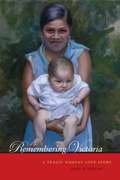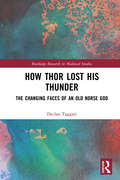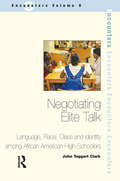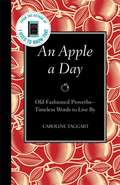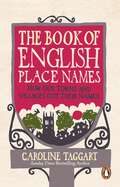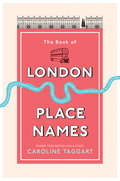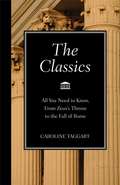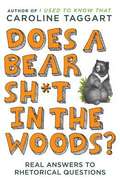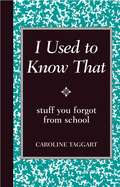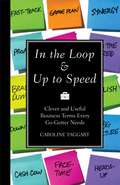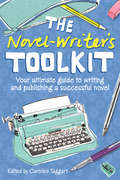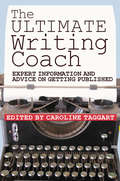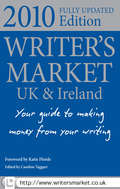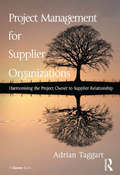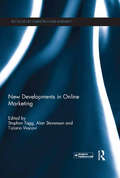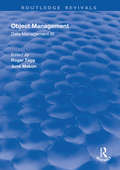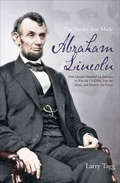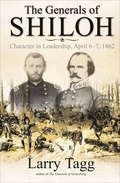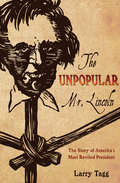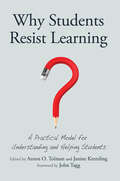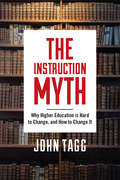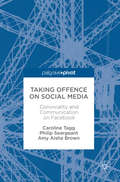- Table View
- List View
Remembering Victoria: A Tragic Nahuat Love Story
by James M. TaggartOn October 15, 1983, a young mother of six was murdered while walking across her village of Huitzilan de Serdán, Mexico, with her infant son and one of her daughters. This woman, Victoria Bonilla, was among more than one hundred villagers who perished in violence that broke out soon after the Mexican army chopped down a cornfield that had been planted on an unused cattle pasture by forty Nahuat villagers.<P><P>In this anthropological account, based on years of fieldwork in Huitzilan, James M. Taggart turns to Victoria's husband, Nacho Angel Hernández, to try to understand how a community based on respect and cooperation descended into horrific violence and fratricide. When the army chopped down the cornfield at Talcuaco, the war that broke out resulted in the complete breakdown of the social and moral order of the community.
Promoting Reflective Thinking in Teachers: 50 Action Strategies
by Dr Germaine L. Taggart Alfred P. WilsonThis expanded bestseller integrates the latest research and technology with tried-and-true methods for strengthening practitioners' problem-solving and decision-making skills.
How Thor Lost His Thunder: The Changing Faces of an Old Norse God (Routledge Research in Medieval Studies)
by Declan TaggartHow Thor Lost his Thunder is the first major English-language study of early medieval evidence for the Old Norse god, Thor. In this book, the most common modern representations of Thor are examined, such as images of him wreathed in lightning, and battling against monsters and giants. The origins of these images within Iron Age and early medieval evidence are then uncovered and investigated. In doing so, the common cultural history of Thor’s cult and mythology is explored and some of his lesser known traits are revealed, including a possible connection to earthquakes and volcanic eruptions in Iceland. This geographically and chronologically far-reaching study considers the earliest sources in which Thor appears, including in evidence from the Viking colonies of the British Isles and in Scandinavian folklore. Through tracing the changes and variety that has occurred in Old Norse mythology over time, this book provokes a questioning of the fundamental popular and scholarly beliefs about Thor for the first time since the Victorian era, including whether he really was a thunder god and whether worshippers truly believed they would encounter him in the afterlife. Considering evidence from across northern Europe, How Thor Lost his Thunder challenges modern scholarship’s understanding of the god and of the northern pantheon as a whole and is ideal for scholars and students of mythology, and the history and religion of medieval Scandinavia.
Negotiating Elite Talk: Language, Race, Class and Identity Among African American High Schoolers
by John Taggart ClarkLen Gregory is a law school student. As part of his elite law school's community outreach programme, he finds himself in a local high school several times a week passing on his own legal knowledge to the students in a course he teaches entitled Street Law. This book shows that passing on legal knowledge is not the only thing Len is doing in Street Law. He is also trying to get his students to talk and argue about the law in the same way that he does. Len talks about legal matters using hypothetical, speculative scenarios played out by generic people - if people occur at all in his scenarios. The students, meanwhile, recount anecdotes inhabited by real people doing things in the real world. This book describes how Len and the Street Law students negotiate Len's language promotion project scheme, that is, how the students go along with or resist Len's promotion. The consequences of this negotiation are high: the abstract/speculative inquiry style promoted by Len carries social value - to be able to talk as Len does is to be able to talk as powerful members of society talk, and Len is offering the Street Law students access to that social capital. However, this book shows how the Street Law students identify abstract/speculative inquiry as being the talk of the (elite, white) Other - not, in other words, a way of talk that, by and large, utters their social identity. The book examines this negotiation and tension between learning economically powerful ways of talking in the larger social marketplace and maintaining an authentic local social identity.
An Apple a Day
by Caroline TaggartFrom Old Testament proverbs to modern phrases like "the best things in life are free," An Apple a Day takes a fun look at expressions that "have stood the test of time." Read through from start to finish or search through the list of hundreds of the most common proverbs, arranged from A to Z for easy reference. You'll learn about each proverb's surprising origins, why some are valid and others are not, the derivation and meanings behind them, and their relevance in today's society. Includes entries like: Two heads are better than one: Like the less-familiar "Four eyes see better than two," this proverb extols the benefits of having someone else help you make up your mind-and it's a view that goes back to at least the fourteenth century. But while it is always useful to have a second opinion (A sounding board? Someone else to blame?) it might also be worth bearing in mind the disadvantages of design or decision-making by committee: something that really pleases no one. So whereas two heads may well be better than one, three could be a crowd. Laughter is the best medicine: This idea is an ancient one and is found in, appropriately, the book of Proverbs: "A merry heart doeth good like a medicine: but a broken spirit drieth the bones." It has prompted a surprising amount of research, with the result that some scientists claim that laughter has the same benefits as a mild workout-it stretches muscles, sends more oxygen to the tissues, and generally makes you feel healthier. One study even claims that laughing heartily for 10-15 minutes burns 50 calories. But let's pause for thought here. The world may laugh with you over a joke or a rerun of Seinfeld, but if you make a habit of laughing heartily for 10-15 minutes for no apparent reason, the world is going to think you are nuts and cross the street to avoid you. It may be worth striving for a happy medium. An apple a day keeps the doctor away: A common British folk saying,
The Book of English Place Names: How Our Towns and Villages Got Their Names
by Caroline TaggartTake a journey down winding lanes and Roman roads in this witty and informative guide to the meanings behind the names of England's towns and villages. From Celtic farmers to Norman conquerors, right up to the Industrial Revolution, deciphering our place names reveals how generations of our ancestors lived, worked, travelled and worshipped, and how their influence has shaped our landscape.From the most ancient sacred sites to towns that take their names from stories of giants and knights, learn how Roman garrisons became our great cities, and discover how a meeting of the roads could become a thriving market town. Region by region, Caroline Taggart uncovers hidden meanings to reveal a patchwork of tall tales and ancient legends that collectively tells the story of how we made England.
The Book of London Place Names
by Caroline TaggartEver wondered if Cheapside really is cheap, what you do in Threadneedle Street, or who the knights of Knightsbridge were?Did you know that Piccadilly is actually an insult? And that Euston Road was built because there were too many cows on Oxford Street? Or that the River Fleet was covered over partly because of a drunken butcher? Take a trip down narrow lanes, through cobbled streets and crowded markets to discover the meanings behind the city’s place names. Meet forgotten residents whose names survive in the places where they lived, such as Sir George Downing of Downing Street, and uncover tales from London’s murky past that have shaped the modern city.From famous landmarks to forgotten rivers, grand thoroughfares to lost palaces, and ancient villages swallowed up as the city grew, Caroline Taggart explains the hidden meanings behind familiar places. If you have ever wanted to learn more about the history of London and discover the people, events and stories that shaped our capital city, then come on a journey that will show you London in a new light...
The Classics
by Caroline TaggartIt's no myth: this lively refresher course fills in all you need to know about ancient studies-from Zeus's throne to the fall of Rome-in pithy little quips. It covers the impressive advances made by Greek and Roman societies, from language to medicine, from art to architecture. You'll learn: The Greek alphabet, from alpha to omega The history and characteristics that define Greek and Roman architecture and its influence on modern building Greek and Latin words, which make up more than 30 percent of the words in the English language, and how you can build your vocabulary by learning the roots The Greek and Roman gods, the mythology surrounding them, and the part these figures play in our culture Almost 1,000 years of Greek and Roman history, from the birth of democracy to Caesar's empire The philosophies taught by Socrates, Plato, and Aristotle and what their ideas have contributed to the world we live in today How modern cultural staples such as the Olympics were formed by classical literature written by authors such as Homer and Cicero A fascinating introduction to the world that became the foundation for Western Civilization, The Classics puts the same information from stuffy textbooks at your fingertips in one entertaining read. Make this and all of the Blackboard Books(tm) a permanent fixture on your shelf, and you'll have instant access to a breadth of knowledge. Whether you need homework help or want to win that trivia game, this series is the trusted source for fun facts.
Does a Bear Sh*t in the Woods?
by Caroline TaggartSerious answers to rhetorical questions--what's not to like? For those of us who have long wondered where bears go to take care of their business, if the Pope is actually Catholic, or whether anyone is really made of money, Caroline Taggart provides the answers to these and a host of previously unanswerable questions. From the most profound questions of philosophy to queries of geography and science, this deadpan book is full of hilarious information you never knew you needed including: What's love got to do with it? How many roads must a man walk down before you call him a man? Where does the time go? Can a leopard change his spots? .
I Used to Know That
by Caroline TaggartThis small but mighty collection will trigger your memory with fun facts you learned in school-from adverbs to the Pythagorean Theorem. Witty, engaging, entertaining-a book you'll pick up again and again. Author Caroline Taggart discovered two things while researching this book and talking with other people: One, everybody had been to school. And two, they had all forgotten entirely different things. Contained in this handy little book are the facts that you learned in school, but may not remember completely or accurately. Covering a variety of subjects, this book features all the most important theories, equations, phrases, and rules we were all taught years ago. Rediscover: * History: The first president to occupy the White House was John Adams in 1800 * Religion: The seven deadly sins and the names of the twelve apostles * Literature: In which Shakespearean play "The quality of mercy" speech appears * Science: The periodic table of elements devised by a Russian chemist in 1889 includes the symbol for lead (Pb), silver (Ag), tin (Sn), and gold (Au) * Nature: How photosynthesis works The information-presented in easy-to-retain, bite-sized chunks-is accurate and up-to- date. It will touch a chord with anyone old enough to have forgotten half of what they learned at school. Here is a perfect gift for every perennial student.
In the Loop & Up to Speed
by Caroline TaggartThe bottom line is this: The workplace is a minefield of business jargon that people exchange on a daily basis, and it can all start to sound like everyone around you is speaking another language. So if you have ever wondered whether you have hit the glass ceiling or if a cubicle monkey will respond to mushroom management, become bogged down in the marzipan layer or are confused about what to do about the elephant in the room, this is the book for you. From indecipherable abbreviations and business terminology to buzzwords, motivational phrases, and more, In the Loop and Up to Speed uncovers the origins and meanings of many useful--and some not so useful--phrases that can be heard in the workplace and in everyday life, such as: · level playing field touching base· reinventing the wheel firing on all cylinders· brainstorming corporate DNA· methodology keeping your options open· raising the bar blue-sky thinking </d
The Novel Writers Toolkit: Your Ultimate Guide To Writing And Publishing A Successful Novel
by Caroline TaggartNovel writing is a popular hobby and this book will provide the would-be and starter novelist with all the tools needed to get started. This title includes a thorough grounding in essential fiction writing skills and clear guidance on how to get published from top industry names. It provides a complete glossary of terms and listing of all publishing contacts needed by an author, from book publishers and agents to festivals and online links. It includes tremendous resource of instruction and information that will prove invaluable to the armies of would-be and practising novel writers.
The Ultimate Writing Coach: Expert Information and Advice on Getting Published
by Caroline TaggartThe Ultimate Writing Coach contains everything you need to know about writing and publishing. It presents authoritative guidance direct from professional writers covering the full gamut of both the fiction and non-fiction market. For fiction, there is coaching on everything from creating believable characters and writing short stories to specialist subjects such as crime and children's fiction. For non-fiction learn from expert advice on travel and technical writing, writing for the web, poetry and biographical writing, and journalism. This invaluable guide also includes succinct, practical guidance on actually getting published, with articles on how to get your submission right for immediate impact, contracts and legal issues, and the financial side.There are handy tips on learning opportunities, whether you're a high school graduate looking to embark on a university degree or a full-time mom looking to take a short course or workshop. And a handy glossary of book trade terminology will ensure you're fully clued up on your industry jargon.
Writer's Market 2010: Make Money Writing
by Caroline TaggartTHE MOST TRUSTED GUIDE TO GETTING PUBLISHED Written by writers for writers and backed by 89 years of authority, Writer's Market is the #1 resource for helping writers sell their work. Used by both seasoned professionals and writers new to the publishing world, Writer's Market has helped countless writers transform their love of writing from a hobby into a career. Nowhere else but in the 2010 Writer's Market will you find the most comprehensive and reliable information you need. This new edition includes: Complete, up-to-date contact information and submission guidelines for more than 3,500 market listings, including literary agents, book publishers, magazines, newspapers, production companies, theaters, greeting card companies, and more. Informative interviews, helpful tips and instructional articles on the business of writing. The "How Much Should I Charge?" pay rate charts for professional freelancers. Sample good and bad queries in the "Query Letter Clinic." Easy-to-use format and tabbed pages so you can quickly locate the information you need!
Project Management for Supplier Organizations: Harmonising the Project Owner to Supplier Relationship
by Adrian TaggartConventionally, the literature on project management presents the story from the project client, or Owner’s, perspective. Project Management for Supplier Organizations turns this on its head and explores the challenges and remedies from the perspective of the vendors providing the necessary goods and services to a project. It explains the likely impact on the structure, culture, and procedures of Suppliers and identifies the additional competences they may require. It offers new insights, frameworks and models, in particular a new Supplier Organization’s Project Lifecycle Model, that integrate the role of the Supplier as a member of the Owner’s project team with their own necessary commercial activities such as marketing and selling. For Suppliers, this unlocks the contents of the various Bodies of Knowledge, by showing how and where the tools and techniques of project management apply to their particular role. The text explores in some detail the shared and divergent interests of Suppliers and Owners and shows how a well thought-out and carefully executed procurement process maximises the former and diminishes the latter. Such an insight is equally valuable for any Owner Organization. Adrian Taggart’s book provides a refreshing and essential perspective. For Suppliers managing their role in a project, it offers a real insight and an urgent set of priorities. For Owners it shows how best they can work with their suppliers to mutual benefit.
New Developments in Online Marketing (Key Issues in Marketing Management)
by Stephen Tagg Alan Stevenson Tiziano VescoviThere can be little doubt about the profound impact that the Internet has had on all aspects of business over the past decade. Indeed, it is now widely accepted that we have entered a new and even more revolutionary phase in the development of the Net as a global marketing and communications platform; a phase characterised by information ‘pull’ rather than ‘push’, user-generated content, openness, sharing, collaboration, interaction, communities, and social networking. New generation Web-based communities and hosted applications are beginning to have a major impact on customer behaviour across a diverse range of industries. These new applications represent a fundamental change in the way people use the Internet, their online expectations, and experiences. From a marketing perspective, the most distinctive feature is not the technology involved but rather the growth of a new global culture – a ‘Net generation’ culture based on decentralised authority rather than hierarchy and control, online socialising and collaboration, user-generated and distributed content, open communications, peer-to-peer sharing, and global participation. Success in this new online environment, characterised by people and network empowerment, requires new ‘mindsets’ and innovative approaches to marketing, customer, and network relationships. This book makes a valuable contribution to the field by examining recent and future developments in online marketing, including the revolutionary impact of new media. Chapters cover a wide range of topics, including: information exchange on bulletin board systems and in online consumer portals; Web 2.0 and ‘New-Wave Globals’; online tribal marketing; co-creation; industry impact; privacy issues; online advertising effectiveness; and practitioner prognostics for the future of online marketing. This book was originally published as a special issue of the Journal of Marketing Management.
Object Management (Routledge Revivals)
by Roger Tagg June MabonFirst published in 1992, this volume explores the use of object oriented methods which is forecast to grow rapidly, with their flexibility and facility to overcome some of the inadequacies of relational databases. This timely book reviews their potential in the data management context. It examines the impact of object oriented techniques on the practice of data management including data analysis, database design, database administration and DBMS operation. The main emphasis of the book is on practical experience of developing and applying 00 methods in the most popular application areas. Its four parts covering the background to object technology, the products, the applications and the implications.
Harold Bell Wright: Storyteller to America (Great West and Indian Series, Vol #49)
by Lawrence V. Taggx
The Battles that Made Abraham Lincoln: How Lincoln Mastered his Enemies to Win the Civil War, Free the Slaves, and Preserve the Union
by Larry TaggA timely look at the atmosphere of political hostility surrounding the Civil War, and the venom faced by America&’s sixteenth president. Today, Abraham Lincoln is a beloved American icon, widely considered to be our best president. It was not always so. This book takes a look at what Lincoln&’s contemporaries actually thought and said about him during his lifetime, when political hostilities, and ultimately civil war, raged. The era in which our sixteenth president lived and governed was the most rough-and-tumble in the history of American politics. The hostility behind the criticism aimed at Lincoln by the great men of his time, on both sides of the Mason-Dixon line, is startling, the spectacular prejudice against him often shocking for its cruelty, intensity, and unrelenting vigor. The plain truth is that Lincoln was deeply reviled by many in his time. This book is both an entertaining read and a well-researched, serious look at the political context that begat the president&’s predicament. Lincoln&’s humanity has been unintentionally trivialized by some historians and writers who have hidden away the real man in a patina of bronze. This book helps us better understand the man he was, and how history is better and more clearly viewed through a long-distance lens. &“Not the warm and fuzzy portrait we&’re used to seeing . . . An eye-opening study, the first of its kind to focus on what Lincoln&’s contemporaries really thought of him. On the other hand, this is not mean-spirited Lincoln-bashing . . . Tagg assesses his presidency through the social and political context of mid-19th century America. It was a time, for example, when &‘the rabid press routinely destroyed the reputations of public men,&’ when the stature of the presidency, &‘stained by feeble performances from a string of the poorest presidents in the nation&’s history,&’ had plunged over decades.&” —Civil War Times Magazine
The Generals of Gettysburg: the Leaders of America's Greatest Battle
by Larry TaggFilled with insightful anecdotes and lively narrative, The Generals of Gettysburg presents detailed information on the character and personality of all 133 combat-command officers as well as an in-depth account of each man's actions on the field. This marriage of character --the features and attributes of a man--with each general's battlefield record, offers new insights into the battle and its outcome.
The Generals of Shiloh: Character in Leadership, April 6–7, 1862
by Larry TaggThe author of The Generals of Gettysburg examines the characters and actions of the military leadership at this Tennessee Civil War battle. “Character is destiny,” wrote the Greek philosopher Heraclitus more than twenty-five centuries ago. Most writers of military history stress strategy and tactics at the expense of the character of their subjects. Larry Tagg remedies that oversight with The Generals of Shiloh, a unique and invaluable study of the high-ranking combat officers whose conduct in April 1862 helped determine the success or failure of their respective armies, the fate of the war in the Western Theater, and, in turn, the fate of the American union. Tagg presents detailed background information on each of his subjects, coupled with a thorough account of each man’s actions on the field of Shiloh and, if he survived that battle, his fate thereafter. Many of the great names are found here in this early battle, from Ulysses S. Grant, William T. Sherman, and Don Carlos Buell to Albert S. Johnston, Braxton Bragg, and P. G. T. Beauregard. Many more men, whose names crossed the stage of furious combat only to disappear in the smoke on the far side, also populate these pages. Each acted in his own unique fashion. This marriage of character (“the features and attributes of a man”) with his war record offers new insights into how and why a particular soldier acted a certain way, in a certain situation, at a certain time. Nineteenth century combat was an unforgiving cauldron. In that hot fire some grew timid and listless, others demonstrated a tendency toward rashness, and the balance rose to the occasion and did their duty as they understood it. This book explores all of their individual stories. “Does a good job of shining a bright light upon the great preponderance of highly placed citizen-generals in the Shiloh armies.” —Civil War Books and Authors
The Unpopular Mr. Lincoln: The Story of America's Most Reviled President
by Larry TaggA timely look at the atmosphere of political hostility surrounding the Civil War, and the venom faced by America’s sixteenth president. Today, Abraham Lincoln is a beloved American icon, widely considered to be our best president. It was not always so. This book takes a look at what Lincoln’s contemporaries actually thought and said about him during his lifetime, when political hostilities, and ultimately civil war, raged. The era in which our sixteenth president lived and governed was the most rough-and-tumble in the history of American politics. The hostility behind the criticism aimed at Lincoln by the great men of his time, on both sides of the Mason-Dixon line, is startling, the spectacular prejudice against him often shocking for its cruelty, intensity, and unrelenting vigor. The plain truth is that Lincoln was deeply reviled by many in his time. This book is both an entertaining read and a well-researched, serious look at the political context that begat the president’s predicament. Lincoln’s humanity has been unintentionally trivialized by some historians and writers who have hidden away the real man in a patina of bronze. This book helps us better understand the man he was, and how history is better and more clearly viewed through a long-distance lens. “Not the warm and fuzzy portrait we’re used to seeing . . . An eye-opening study, the first of its kind to focus on what Lincoln’s contemporaries really thought of him. On the other hand, this is not mean-spirited Lincoln-bashing . . . Tagg assesses his presidency through the social and political context of mid-19th century America. It was a time, for example, when ‘the rabid press routinely destroyed the reputations of public men,’ when the stature of the presidency, ‘stained by feeble performances from a string of the poorest presidents in the nation’s history,’ had plunged over decades.” —Civil War Times Magazine
Why Students Resist Learning: A Practical Model for Understanding and Helping Students
by John Tagg Anton O. Tolman Janine KremlingHowever personally committed faculty may be to helping students learn, their students are not always as eager to participate in this endeavor, and may react with both active and passive resistant behaviors, including poor faculty evaluations. The purpose of this book is to help faculty develop a coherent and integrated understanding of the various causes of student resistance to learning, providing them with a rationale for responding constructively, and enabling them to create conditions conducive to implementing effective learning strategies. In this book readers will discover an innovative integrated model that accounts for student behaviors and creates a foundation for intentional and informed discussion, evaluation, and the development of effective counter strategies. The model takes into account institutional context, environmental forces, students’ prior negative classroom experiences, their cognitive development, readiness to change, and metacognition. The various chapters take the reader through the model’s elements, exploring their practical implications for teaching, whether relating to course design, assessments, assignments, or interactions with students.The book includes a chapter written entirely by students, offering their insights into the causes of resistance, and their reflections on how participating on this project has affected them. While of great value for faculty, this book is also useful to faculty developers advising future and current faculty, as well as to administrators, offering insight into how institutional values impact teaching practice and student attitudes.
The Instruction Myth: Why Higher Education is Hard to Change, and How to Change It
by John TaggHigher education is broken, and we haven’t been able to fix it. Even in the face of great and growing dysfunction, it seems resistant to fundamental change. At this point, can anything be done to save it? The Instruction Myth argues that yes, higher education can be reformed and reinvigorated, but it will not be an easy process. In fact, it will require universities to abandon their central operating principle, the belief that education revolves around instruction, easily measurable in course syllabi, credits, and enrollments. Acclaimed education scholar John Tagg presents a powerful case that instruction alone is worthless and that universities should instead be centered upon student learning, which is far harder to quantify and standardize. Yet, as he shows, decades of research have indicated how to best promote student learning, but few universities have systematically implemented these suggestions. This book demonstrates why higher education must undergo radical change if it hopes to survive. More importantly, it offers specific policy suggestions for how universities can break their harmful dependence on the instruction myth. In this extensively researched book, Tagg offers a compelling diagnosis of what’s ailing American higher education and a prescription for how it might still heal itself.
Taking Offence on Social Media
by Caroline Tagg Philip Seargeant Amy Aisha BrownThis book explores communication on Facebook, developing the new theoretical concept of context design as a way of understanding the dynamics of online interaction. Against a backdrop of fake news and other controversies surrounding online political debate, the authors focus on inadvertent acts of offence on Facebook; that is, when users of the site unwittingly offend or are offended by the airing of political or religious views, or of opinions deemed racist or sexist. Drawing on a survey of Facebook users, they explain why instances of offence occur and what users report doing in response. They argue that Facebook users contribute to the construction of a particular social space, one that is characterised by online conviviality and a belief that Facebook is not the place for serious debate. These views in turn shape the kind of political debate that can take place on the site. This thought-provoking book will appeal to scholars and students of applied linguistics, and anyone interested in the role of social media in contemporary political and social life.
